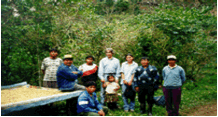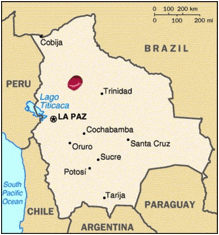 Small, independent coffee farmers located twelve hours from La Paz were freed in 1991 from slavery. While working to improve their lives and environment, they produce a slightly spicy coffee. It has a full, creamy body, mild acidity, and is well balanced with light chocolatey notes.
Small, independent coffee farmers located twelve hours from La Paz were freed in 1991 from slavery. While working to improve their lives and environment, they produce a slightly spicy coffee. It has a full, creamy body, mild acidity, and is well balanced with light chocolatey notes.
 The Region
The Region
Twelve hours from La Paz, Bolivia in the state of La Paz, lie several small communities and villages. Here in the southern end of the expansive Andes Mountain chain, life is hard and the challenges are many. This area’s ecological designation is known as “humid subtropic forest”. Elevations range from 1300-1800 meters (4225 – 5850 feet). The average size of the organic coffee farms here are 1.25 to 4.5 hectares (3 to 11 acres). The terrain is rugged and steep, and the forest is lush and beautiful. One of the main forest tree species here is mahogany.
The People
These coffee farmers are known as “Colonials”. During the 1950′s, wealthy and large landowners took over this region. They confiscated properties from the native people, then enslaved them by forcing the natives to work for them. In 1991, through a governmental land reform, the larger landowners were made to relinquish holding these small farms and return rightful ownership back to the families who originally owned them.
These small farms still surround those of the large landowners, but they are no longer reliant on the large landowners for their survival. They are independent and have title to their own land. They now have freedom to search for ways to improve their income, their own lives, and the health of their community.
There are 41 small coffee producers that participate in this region’s organic coffee project. These coffee farmers have been working with a Bolivian organic organization to learn ways to improve their cultivation practices, to increase production, and to improve their environment. Our importer has made commitments with these growers, their families, and community leaders to support this project not only by buying their organic coffee but also by working with them to accomplish the following mutually agreed on goals:
- Improve existing patios and build wood framed raised structures for drying wet paragamino
- Improve coffee seed propagation and develop nursery stock
- Support coffee technicians in training farmers in better pruning techniques
- Prune forest/jungle trees to allow more sunlight (even shade grown coffee needs a minimum of 60% sunlight to grow well)
- Support and promote better composting
The Coffee
The coffee trees are older cultivars: Typica and Bourbon. During the harvest period there are three cherry pickings: March-April, May-June, and August-September. The coffee cherries are hand picked, usually by women in the communities when the cherries reach full maturity, full red cherry. When the coffee tree is too tall to reach the cherries, ladders made of mahogany are used.
The cherry pickers sometimes use a wooden pole placed in the crotch of two trees, then balance themselves on the pole above the ground to reach the higher coffee cherries. The coffee grain, or bean itself, is medium-large in size. The coffee is slightly spicy, full to heavy bodied, with mild acidity and a good balance. It is featured in Storm Chaser.
Featured In

Espresso Blend
Dark Roast
Lighter Bolivian roast than Storm Chaser with many of the same attributes: slightly sweet, complex, and spicy.

Storm Chaser
Dark Roast
One of our darkest roasts, the Colonial Caranavi Bolivian bean produces a slightly spicy, full to heavy bodied, mild acidity coffee that is difficult to describe but a favorite of anyone preferring dark roasts.



